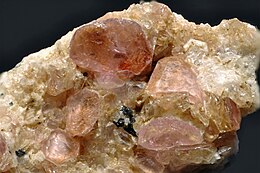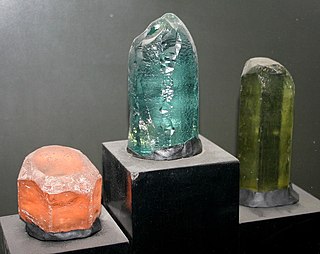
Beryl ( BERR-əl) is a mineral composed of beryllium aluminium silicate with the chemical formula Be3Al2Si6O18. Well-known varieties of beryl include emerald and aquamarine. Naturally occurring, hexagonal crystals of beryl can be up to several meters in size, but terminated crystals are relatively rare. Pure beryl is colorless, but it is frequently tinted by impurities; possible colors are green, blue, yellow, pink, and red (the rarest). It is an ore source of beryllium.
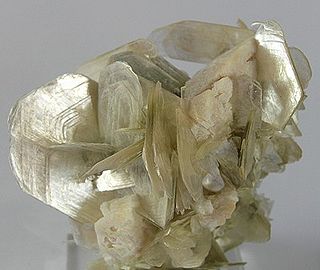
Muscovite (also known as common mica, isinglass, or potash mica) is a hydrated phyllosilicate mineral of aluminium and potassium with formula KAl2(AlSi3O10)(F,OH)2, or (KF)2(Al2O3)3(SiO2)6(H2O). It has a highly perfect basal cleavage yielding remarkably thin laminae (sheets) which are often highly elastic. Sheets of muscovite 5 meters × 3 meters (16.5 feet × 10 feet) have been found in Nellore, India.

Topaz is a silicate mineral of aluminium and fluorine with the chemical formula Al2SiO4(F,OH)2. It is used as a gemstone in jewelry and other adornments. Common topaz in its natural state is colorless, though trace element impurities can make it pale blue or golden brown to yellow orange. Topaz is often treated with heat or radiation to make it a deep blue, reddish-orange, pale green, pink, or purple.
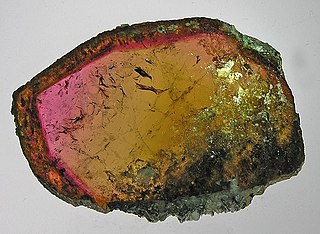
Tourmaline is a crystalline silicate mineral group in which boron is compounded with elements such as aluminium, iron, magnesium, sodium, lithium, or potassium. This gemstone comes in a wide variety of colors.

A pegmatite is an igneous rock showing a very coarse texture, with large interlocking crystals usually greater in size than 1 cm (0.4 in) and sometimes greater than 1 meter (3 ft). Most pegmatites are composed of quartz, feldspar, and mica, having a similar silicic composition to granite. However, rarer intermediate composition and mafic pegmatites are known.

The mineral or gemstone chrysoberyl is an aluminate of beryllium with the formula BeAl2O4. The name chrysoberyl is derived from the Greek words χρυσός chrysos and βήρυλλος beryllos, meaning "a gold-white spar". Despite the similarity of their names, chrysoberyl and beryl are two completely different gemstones, although they both contain beryllium. Chrysoberyl is the third-hardest frequently encountered natural gemstone and lies at 8.5 on the Mohs scale of mineral hardness, between corundum (9) and topaz (8).
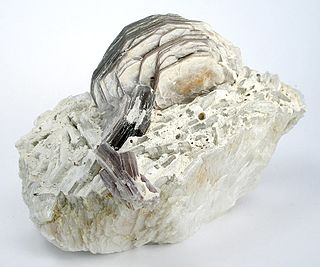
Lepidolite is a lilac-gray or rose-colored member of the mica group of minerals with chemical formula K(Li,Al)3(Al,Si,Rb)4O10(F,OH)2. It is the most abundant lithium-bearing mineral and is a secondary source of this metal. It is the major source of the alkali metal rubidium.
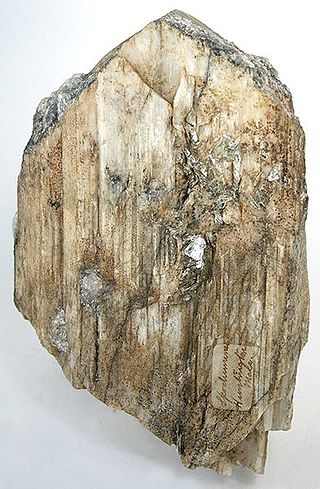
Spodumene is a pyroxene mineral consisting of lithium aluminium inosilicate, LiAl(SiO3)2, and is a commercially important source of lithium. It occurs as colorless to yellowish, purplish, or lilac kunzite (see below), yellowish-green or emerald-green hiddenite, prismatic crystals, often of great size. Single crystals of 14.3 m (47 ft) in size are reported from the Black Hills of South Dakota, United States.

Cordierite (mineralogy) or iolite (gemology) is a magnesium iron aluminium cyclosilicate. Iron is almost always present and a solid solution exists between Mg-rich cordierite and Fe-rich sekaninaite with a series formula: (Mg,Fe)2Al3(Si5AlO18) to (Fe,Mg)2Al3(Si5AlO18). A high-temperature polymorph exists, indialite, which is isostructural with beryl and has a random distribution of Al in the (Si,Al)6O18 rings.
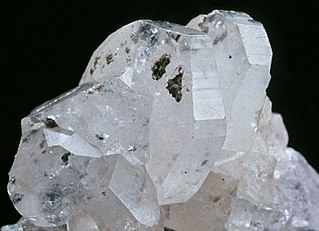
Phenakite or phenacite is a fairly rare nesosilicate mineral consisting of beryllium orthosilicate, Be2SiO4. Occasionally used as a gemstone, phenakite occurs as isolated crystals, which are rhombohedral with parallel-faced hemihedrism, and are either lenticular or prismatic in habit: the lenticular habit is determined by the development of faces of several obtuse rhombohedra and the absence of prism faces. There is no cleavage, and the fracture is conchoidal. The Mohs hardness is high, being 7.5–8; the specific gravity is 2.96. The crystals are sometimes perfectly colorless and transparent, but more often they are greyish or yellowish and only translucent; occasionally they are pale rose-red. In general appearance the mineral is not unlike quartz, for which indeed it has been mistaken. Its name comes from Ancient Greek: φέναξ, romanized: phénax, meaning "deceiver" due to its close visual similarity to quartz, named by Nils Gustaf Nordenskiöld in 1833.

Spessartine is a nesosilicate, manganese aluminium garnet species, Mn2+3Al2(SiO4)3. This mineral is sometimes mistakenly referred to as spessartite.

Lithiophilite is a mineral containing the element lithium. It is lithium manganese(II) phosphate with chemical formula LiMnPO4. It occurs in pegmatites often associated with triphylite, the iron end member in a solid solution series. The mineral with intermediate composition is known as sicklerite and has the chemical formula Li(Mn,Fe)PO4). The name lithiophilite is derived from the Greek philos (φιλός) "friend", as lithiophilite is usually found with lithium.

Pollucite is a zeolite mineral with the formula (Cs,Na)2Al2Si4O12·2H2O with iron, calcium, rubidium and potassium as common substituting elements. It is important as a significant ore of caesium and sometimes rubidium. It forms a solid solution series with analcime. It crystallizes in the isometric–hexoctahedral crystal system as colorless, white, gray, or rarely pink and blue masses. Well formed crystals are rare. It has a Mohs hardness of 6.5 and a specific gravity of 2.9. It has a brittle fracture and no cleavage.

The mineral zektzerite is a member of the tuhualite group and was first found in 1966 by Seattle mineralogist Benjamin Bartlett "Bart" Cannon. It was discovered in the Willow creek basin below Silver Star mountain in miarolitic cavities within the alkaline arfvedsonite granite phase of the Golden Horn batholith, Okanogan County, Washington. It is named for Jack Zektzer, mathematician and mineral collector of Seattle, Washington.
Bityite is considered a rare mineral, and it is an endmember to the margarite mica sub-group found within the phyllosilicate group. The mineral was first described by Antoine François Alfred Lacroix in 1908, and later its chemical composition was concluded by Professor Hugo Strunz. Bityite has a close association with beryl, and it generally crystallizes in pseudomorphs after it, or in cavities associated with reformed beryl crystals. The mineral is considered a late-stage constituent in lithium bearing pegmatites, and has only been encountered in a few localities throughout the world. The mineral was named by Lacroix after Mt. Bity, Madagascar from where it was first discovered.
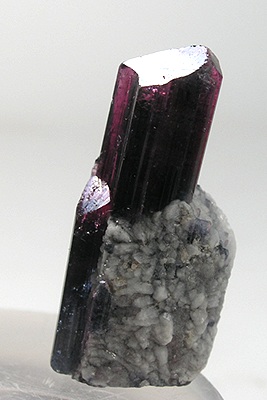
Fluor-liddicoatite is a rare member of the tourmaline group of minerals, elbaite subgroup, and the theoretical calcium endmember of the elbaite-fluor-liddicoatite series; the pure end-member has not yet been found in nature. Fluor-liddicoatite is indistinguishable from elbaite by X-ray diffraction techniques. It forms a series with elbaite and probably also with olenite. Liddiocoatite is currently a non-approved mineral name, but Aurisicchio et al. (1999) and Breaks et al. (2008) found OH-dominant species. Formulae are

Ferronigerite-2N1S is an iron, tin, alumino-hydroxide mineral that naturally occurs around sillimanite-quartz veins. Ferronigerite-2N1S belongs to the nigerite group, högbomite supergroup. The other constituents of the nigerite group are ferronigerite-6N6S, magnesionigerite-2N1S, magnesionigerite-6N6S, zinconigerite-2N1S and zinconigerite-6N6S. The 2N1S ending stands for the nolanite and spinel structural layers.

Morganite is an orange or pink variety of beryl and is also a gemstone. Morganite is mined in Brazil, Afghanistan, Mozambique, Namibia, the United States, and Madagascar.
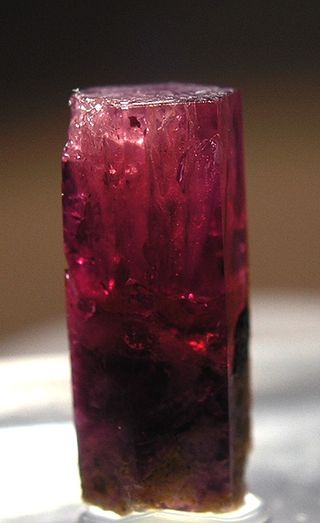
Red beryl, formerly known as bixbite and marketed as red emerald or scarlet emerald, is an extremely rare variety of beryl as well as one of the rarest minerals on Earth. The gem gets its red color from manganese ions embedded inside of beryllium aluminium cyclosilicate crystals. The color of red beryl is stable up to 1,000 °C (1,830 °F). Red beryl can come in various tints like strawberry, bright ruby, cherry, and orange.
Uranopolycrase is an oxide mineral first discovered in the Fonte del Prete vein of a pegmatite vein in San Piero in Campo, Elba Island, Tuscany, Italy. Uranopolycrase is a member of the Euxenite Group and is the uranium bearing analog of polycrase-(Y). The type specimen is almost entirely metamict. The ideal formula for uranopolycrase is (U,Y)(Ti,Nb)2O6. The mineral has been approved by the Commission on New Minerals and Mineral Names of the International Mineralogical Association to be named uranopolycrase for its similarity to polycrase-(Y) and was approved 5 December, 1991.
